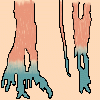|
Caves develop in a variety of rock types, eg limestone, marble, sandstone, lava tubes, ice. Speleothems are the cave decorations: the mineral deposits such as stalactites and stalagmites. The term is not generally given to the gravel and mud deposits; they are usually referred to as clastics, however some altered clastics could be classed as speleothems. In lava tubes, many of the features could rightly be called "speleothems" because their formation involves a chemical change (albeit at high temperature). |
 |
The examples on this site are from caves in Eastern Australia, as that is the author's primary expertise, however you may see analogues in showcaves closer to your area.
What this site is (and what it is not!)This site is not intended to be a replacement for the book, Cave Minerals of the World by Hill and Forti, (see Hill & Forti below) but is intended to be supplementary to the book. If you would like a good grounding in the subject of cave deposits, "Hill & Forti" should be first consulted. After the second edition of Hill & Forti was published, I noted that there are a few items that either didn't quite make the book, or were discovered since the book was published, so I hoped to include some of these items here. |
 |
This site is mostly organised along the same classification scheme as "Hill & Forti" to make things easier to correlate, however I have added a section "By Zone" as there are some aspects of physical location in a cave that determine the forms taken by speleothems.
Why bother with speleothems?
I would like to argue that, for purposes of cave conservation, that any deposit in a cave, be it clastic, speleothem or bedrock formation be afforded the protection of a heritage site. Unlike the earth's surface, caves are not subject to the same weathering processes so what is found inside them often represents a different "snapshot" of the earth's history than would otherwise be available from the surface.
Additionally there are a number of interesting microorganisms responsible for the development and coloration of some speleothems. Surely they are also worthy of protection.
Before we can successfully colonise other planets, we need to be able to appreciate the microflora and mineral structures which develop on (in?) our own planet.
Hopefully this site may help to convince you that this is the case.
References and Further Reading
- International Union of Speleology: http://www.uis-speleo.org/
- Carol A Hill and Paulo Forti, eds. "Cave Minerals of the World", 2nd ed 1997, National Speleological Society, Huntsville, Alabama, USA. ISBN 1-879961-07-5
- Moore, George W., and Sullivan, Nicholas, 1997. Speleology: Caves and the Cave Environment. Cave Books. ISBN 0-939748-46-0
Cosmetic update September 2025